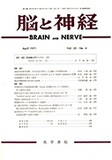Japanese
English
- 有料閲覧
- Abstract 文献概要
- 1ページ目 Look Inside
はじめに
軟骨腫chondromaは長骨に好発し,多発性のことが多い。稀に頭蓋底にも単発し,頭蓋腔内に発育し神経症状を呈するため特異な脳腫瘍として扱われている。
本邦では坂田一記ら30)(1968),斎藤勇ら29)(1968),狩野忠雄ら19)(1969),狩野光将ら18)(1970)による手術で確認された計5例の報告があるにすぎない。
Cartilaginous tumors arising from the skull or intracranial structures are of very rare occurrence. Their incidence is approximately 0.22% of all in-tracranial space-occupying lesions. From case reports, several groups can be separated. Those which arise solitarily from the base of the skull are the most defined and largest group. There have been 52 such tumors reported, 5 of which are Japanese cases. The authors encountered one case presenting Garcin's syndrome, i. e. "syndrome paralytique unilatéral global des nerfs craniens" and in this paper the clinical and pathological findings are described.
CASE REPORT: A female, born in 1919, com-plained of diplopia in April 1966. Complete oph-thalmological examination, including roentgenogra-phic study, revealed no abnormality at that time. About one year later, dysphagia and hoarseness developed. Examination revealed paresis of left V, VI, VIII, IX, X, XI and XII cranial nerves without other neurologic and physical manifestations. When she was admitted to the Nagoya University Hospital on March 8, 1968, neurologic examination gave normal results except for paresis of the left cranial nerves III-XII. The optic fundi were negative. Roentgenograms of the skull revealed definite des-truction on the medial part of the floor of the left middle and posterior fossae. There was no intra-cranial calcification. Arteriographies showed that theleft carotid artery in the region of the tumor was attenuated and the basilar artery was displaced upward. Standard glucose tolerance test was diabetic ; otherwise laboratory findings were essentially nega-tive.
A suhoccipital craniectomy was performed on May 21, 1969. A hard nodular tumor was seen to arise extradurally from the base of the posterior fossa and to occupy the left paraclival area. A part of the tumor was removed piecemeal. The histologic diagnosis was chondrosarcoma. Her general condi-tion continued to deteriorate and she died five months after operation.
Postmortem examination showed a large extradural tumor extending from the superior orbital fissure almost to the foramen magnum. It was bony in consistency, with irregular and soft parts of brownish appearance. The bony portion of the tumor was histologically a mixture of benign chondroma and chondosarcoma. The cells in the sarcomatous places were spindle-shaped and undifferentiated. The soft portions contained brownish myxoid fluid and many small cartilaginous nodules. The leptomen-inges and the mucous membranes of paranasal and nasal cavities were not invaded by tumor.
Certain conclusions regarding the solitary chond-roma of the skull base can be drawn from the review of the literature as well as our case. There is no particular sex predilection. Age at onset ranges between 12 and 66 with highest occurrence duringthe 3rd decade. The most preferential location of the tumors is the synchondroses and synostoses of basicranium, especially those around the sella turcica, followed by those in the cerebellopontine region. Radiographically there are calcifications in the para-sellar chondromas, but cerebellopontine ones are poorly calcified. Radiolucent defects may be re-cognized in the involved bone. Cerebral angiography may give supplementary information as far as localiz-ing and judging the extent of the tumor, but is not helpful in determining the nature of the tumor. Preoperative diagnosis can be almost impossible, especially when no calcification is recognized radio-logically.
The cardinal neurologic signs are multiple cranial nerve involvements varying the location of the lesions. Those situating around the sella turcica give paresis of the II, III, IV, V and VI cranial nerves, and are occasionally responsible for chiasmal syndrome and may also include pituitary signs. Chondromas in the posterior fossa are likely to pro-duce dysfunction of the cranial nerves VII-XII. Some cases resembled acustic neurinoma. Only three cases have been hitherto described which illustrated the syndrome of unilateral global cranial nerve palsy of Garcin.
There is no effective treatment besides surgical operation. Most reports, however, have revealed that partial removal only is possible.

Copyright © 1971, Igaku-Shoin Ltd. All rights reserved.


